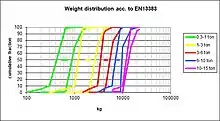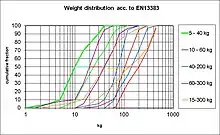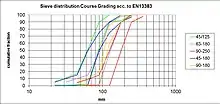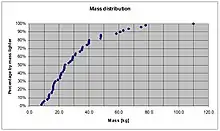Armourstone
Armourstone is a generic term for broken stone with stone masses between 100 and 10,000 kilograms (220 and 22,050 lb) (very coarse aggregate) that is suitable for use in hydraulic engineering. Dimensions and characteristics for armourstone are laid down in European Standard EN13383.[1] In the United States, there are a number of different standards and publications setting out different methodologies for classifying armourstone, ranging from weight-based classifications to gradation curves and size-based classifications.[2]

Stone Classes
European Practice to EN13383



Armourstone is available in standardised stone classes, defined by both a lower and upper value of the stone mass within these classes. For instance, Class 60-300 signifies that up to 10% of the stones weigh less than 60 kg (130 lb) and up to 30% weigh more than 300 kg (660 lb). The standard also mentions values which shouldn't be exceeded by 5% or 3%.
For particular applications like a top layer for a breakwater or bank protection, the median stone mass size, known as M50, is frequently required. This pertains to a category A stone. It doesn't relate to category B stone. There are two main groups: HM and LM, standing for Heavy and Light respectively. A stone class might be defined according to EN 13383 as, for instance, HMA300-1000.
The accompanying graphs offer an overview of all stone classes. A distribution between the two curves in the graph fulfils the criteria for category B. Furthermore, for category A compliance, the MEM should intersect the short horizontal line. MEM represents the average stone mass, meaning the total sample mass divided by the count of stones in that sample. It's worth noting that in wider ranges, notably 15-300 and 40-400, there's a considerable difference; for the 15-300 class, M50 is 1.57 times the MEM.[3][4]
Additionally, there's a defined stone class called CP (Coarse). Despite its name suggesting otherwise, the class CP is smaller than LM. This naming convention exists because this class corresponds to the coarse category in the standard for fractional stone used as supplemental material (aggregate). For the CP stone class, size isn't denoted in kg, but in mm. Based on the primary data from standard EN13383, the following table is presented:[3]
| Class name | range for MEM (kg) | range for d50 (cm) | ratio d85/d16 | calculation value for dn50 (cm) | layer thickness (2 dn50) (cm) | min. dumping quantity with layer thickness 2*dn50 (kg/m²) |
|---|---|---|---|---|---|---|
| CP45/125 | 0.4 - 1.2 | 6.3 - 9.0 | 2.8 | 6.4 | 20 | 300 |
| CP63/180 | 1.2 - 3.8 | 9.0 - 12.5 | 2.8 | 9.0 | 20 | 300 |
| CP90/250 | 3.1 - 9.3 | 12.5 - 18 | 2.8 | 12.8 | 20 | 300 |
| CP45/180 | 0.4 - 1.2 | 6.3 - 9.0 | 4.0 | 6.4 | 20 | 300 |
| CP90/180 | 2.1 - 2.8 | 11 - 12 | 2.0 | 9.7 | 20 | 300 |
| LMA5-40 | 10 - 20 | 15 - 20 | 1.7 | 17 | 35 | 525 |
| LMA10-60 | 20 - 35 | 20 - 24 | 1.5 | 21 | 42 | 630 |
| LMA40-200 | 80 -120 | 31 - 36 | 1.5 | 34 | 68 | 1020 |
| LMA60-300 | 120 - 190 | 36 - 41 | 1.5 | 38 | 76 | 1140 |
| LMA15-300 | 45 - 135 | 26 - 37 | 2.7 | 31 | 62 | 930 |
| HMA300-1000 | 540 - 690 | 55 - 64 | 1.4 | 59 | 118 | 1770 |
| HMA1000-3000 | 1700 -2100 | 86 - 92 | 1.4 | 90 | 180 | 2700 |
| HMA3000-6000 | 4200 - 4800 | 117 - 122 | 1.2 | 118 | 236 | 3540 |
| HMA6000-10000 | 7500 - 8500 | 141 - 147 | 1.2 | 144 | 288 | 4320 |
| HMA10000-15000 | 12000 - 13000 | 165 - 170 | 1.2 | 168 | 336 | 5040 |
Practice in the United States
Several standards and guidelines are identified for classifying armourstone used in coastal and river engineering in the United States, some of which are summarised in the following table:
| Standard/Publication | Notes |
|---|---|
| Hydraulic Engineering Circular 11 (HEC-11) (Brown and Clyde, 1989)[5] | Identifies six weight classes based on the minimum allowable d50. Classes range from “facing” (75 lbs) to 2 tonnes. |
| California Bank and Shore Rock Slope Protection Design, CABS (Racin et al., 2000)[6] | Provides nine weight classes based on the minimum allowable W50. Classes range from “light” (200 lbs), to 8 tonnes. Also provides three classes of “backing” stone, all having a minimum allowable W50 less than 75 lbs. |
| Engineer Manual 1601 (United States Army Corps of Engineers, 1994)[7] | Defines 12 classes using the d100 particle size. Classes are identified in 3-inch increments ranging from 12 in to 54 in. Specifies the minimum and maximum allowable W100, W50, and W15 for each class. |
| Hydraulic Design Series No. 6 (HDS 6) (Richardson et al., 2001)[8] | Establishes an “ideal” gradation curve using the designer’s d50 size. References to USACE procedures for establishing upper and lower limiting curves are made. |
| American Society for Testing of Materials Standard Practice D 6092 (ASTM, 2021)[9] | Provides six weight classes based on the minimum allowable W50. Classes range from “R-20” (20 lbs) to “R-1500” (1,500 lbs). The standard also provides conversions to equivalent size using different shapes and considers specific gravities ranging from 2.60 to 2.75. The standard does not cover large armourstone employed for outer harbour structures such as breakwaters, revetments. |
These standards provide different methodologies for classifying armourstone, ranging from weight-based classifications to gradation curves and size-based classifications. Guidance for the use of large armourstone is given in various USACE publications including the Coastal Engineering Manual.[10][11][12]
Median Stone Mass M50


For fine-grained materials, such as sand, the size is typically represented by the median diameter. This measurement is ascertained by sieving the sand. However, for armourstone, producing a sieve curve isn't feasible because the stones are too large for sieving. Therefore, the M50 measurement is employed. It is calculated by obtaining a sample of stones, determining the mass of each stone, arranging these masses by size, and then creating a cumulative mass curve. Within this curve, one can identify the M50 value. It's essential to note that the term median stone mass is technically inaccurate, as the stone with mass M50 doesn't necessarily represent the median stone in the sample.
To illustrate, consider a sample of 50 stones sourced from a quarry in Bulgaria. The blue rectangle is of A4 size. Every stone's weight is individually recorded, and their masses are illustrated in the attached graph. The horizontal axis represents the individual stone mass, while the vertical axis denotes the cumulative mass as a percentage of the entire sample's mass. At the 50% mark, the M50 value is discerned to be 24kg. The true median for this sample is the mean mass of the 25th and 26th stones. In this specific instance, the M50 closely matches the median mass, which is 26kg. This sample meets the criteria for LMA5-40. However, it's important to note that the sample size is insufficient. According to EN13383, such a sample should comprise at least 200 stones.[1]
Nominal Diameter
Many design formulas do not account for stone mass but rather for diameter. As a result, a method for conversion is required. This method is identified as the nominal diameter.[13] Essentially, it represents the size of a cube's edge that weighs the same as the stone. The formula for this is:
Often, the median value is utilised for this purpose, represented as dn50. Typically, the following relationship can be used for conversion:
Here, Fs represents the shape factor. The shape factor can vary substantially, typically ranging between 0.7 and 0.9.
Referring to the aforementioned example from Bulgaria, the dn50 was also determined. Given the local stone's density (which is limestone) stands at 2284 kg/m³, the dn50 is calculated to be 22cm. It may be observed that the stones in the sample appear much larger to the eye. This visual misperception can be attributed to a few particularly large stones within the sample, which distort the overall impression.
Additional Parameters
The EN13383 standard elaborates on numerous parameters that define the quality of armourstone. This includes attributes like the shape parameter (measured as Length/Thickness), resistance to fracturing, and the capacity for water absorption.[16] It's pivotal to understand that while the standard delineates how to characterise the quality of armourstone, it doesn't specify the requisite quality for a given application. Such specifics are typically found in design manuals and guidelines, including the Rock Manual.[14]
Establishing the Necessary Stone Weight
When determining the weight of stone required under the influence of waves, one might utilise the (now dated) Hudson Formula or the Van der Meer formula. For computations pertaining to stone weight in flows, the Izbash formula is advisable. [14]
References
- EN 13383 Armourstone. various national standardisation institutes (like BSI, NNI, DIN). 2002. p. 73.
- Lagasse, P. F.; Clopper, P. E.; Zevenbergen, L. W.; Ruff, J. F. (2006). Riprap design criteria, recommended specifications, and quality control. NCHRP Report. Washington(D.C.): National Academy Press. ISBN 978-0-309-09866-3.
- Schiereck, G.J.; Verhagen, H.J. (2016). Introduction to bed, bank and shoreline protection. Delft, The Netherlands: VSSD. ISBN 978-90-6562-306-5. Retrieved 3 October 2023.
- d'Angremond, K.; van Roode, F.C. (2004). Breakwaters and closure dams. Delft: VSSD/Spon. ISBN 0-415-33256-7.
- Brown, S.A.; Clyde, E.S. (1989). Design of Riprap Revetment (Report). Retrieved 23 October 2023.
- Racin, J.A.; Hoover, T.P.; Crossett Avila, C.M. (2000). California Bank and Shore Rock Slope Protection Design: Practitioner's Guide and Field Evaluations of Riprap Methods (Report). Retrieved 23 October 2023.
- Engineer Manual 1110-2-1601: Hydraulic Design of Flood Control Channels (PDF). United States Army Corps of Engineers. Washington: USACE. 1994. Retrieved 23 October 2023.
{{cite book}}: CS1 maint: others (link) - Richardson, E.V.; Simons, D.B.; Lagasse, P.F. (2001). River Engineering for Highway Encroachments: Highways in the River Environment (Report). Retrieved 23 October 2023.
- "ASTM D6092-21: Standard Practice for Specifying Standard Sizes of Stone for Erosion Control". www.astm.org. 2021. Retrieved 23 October 2023.
- Zakikhani, M.; Harrelson, D.W.; Tillotson, A.L.; Ables, J.D. (2015). User’s Manual for Armor Stone Evaluation Model (ARMOR) : Great Lakes Armor Stone Study (Report). Geotechnical and Structures Laboratory (U.S.). Retrieved 23 October 2023.
- Engineer Manual EM 1110-2-2302: Construction with Large Stone (PDF). Washington: United States Army Corps of Engineers. 1990. Retrieved 23 October 2023.
- "USACE Coastal Engineering Manual". www.publications.usace.army.mil. 2002. Retrieved 23 October 2023.
- van Rijn, L.C. (2019). "Critical movement of large rocks in currents and waves" (PDF). International Journal of Sediment Research. Retrieved 3 October 2023.
- CIRIA, CUR, CETMEF (2007). The Rock Manual: The Use of Rock in Hydraulic Engineering. London: CIRIA C683. p. 1268. ISBN 9780860176831.
{{cite book}}: CS1 maint: multiple names: authors list (link) - Jansen, Laura (2014). Ratio between Stone Diameter and Nominal Diameter. TU Delft, Committee on Hydraulics.
- Hudec, Peter P. (1989). "Durability of Rock as a Function of Grain Size, Pore Size, and the Rate of Capillary Absorption of Water". Journal of Materials in Civil Engineering. 1 (1): 3–9. doi:10.1061/(ASCE)0899-1561(1989)1:1(3).